The Chapel Garden
This small shaded area has a vertical magnificence with ancient ivies climbing up the limestone cliff. It is an ideal location for a shade garden, a haven of coolness in the summer months – or 'Jardin de Fraicheur'.
The gardening climate is the “Mediterranean climate” of wet winters and hot, dry summers. To succeed, this shade garden must be well thought-out, with preparations for autumn planting. Planting in autumn allows new plants to expand their roots in warm soil and be readier for spring growth than if you wait for spring.
The space is dominated by the limestone cliff, covered in ancient climbing plants, and shrubs which have rooted into the cracks. In addition, there are a couple of very old tall cypress trees that limit what will grow beneath. The place looks like the ideal subject of a Victorian watercolourist on the Grand Tour. For these reasons and to add to the mystery we decided to plant some unusual and unexpected specimens.**(see note)
The planting scheme for this little garden has benefitted from much expert advice: the Wynn-Jones’ of Crûg Farm Plants suggesting plants tolerant of dry shade in the Mediterranean; Olivier Ezavin a local fern nurseryman; Dino Pellizzarro, a specialist on Mediterranean and sub-tropical plants.
Initially we considered mostly ferns but subsequently our ideas have evolved to create ground cover of Liriope muscari, Ruscus (Butcher’s Broom) and Aspidistra (Cast-iron Plant) with other shade-loving plants such as Maianthemum and Polygonatum (Solomon’s Seal).
'Shade' means 1 to 2 hours of sun exposure daily, and 'full shade' is less than 1 hour daily. Even so, the level of light is generally much brighter here than in northern Europe, and the shade areas less gloomy.
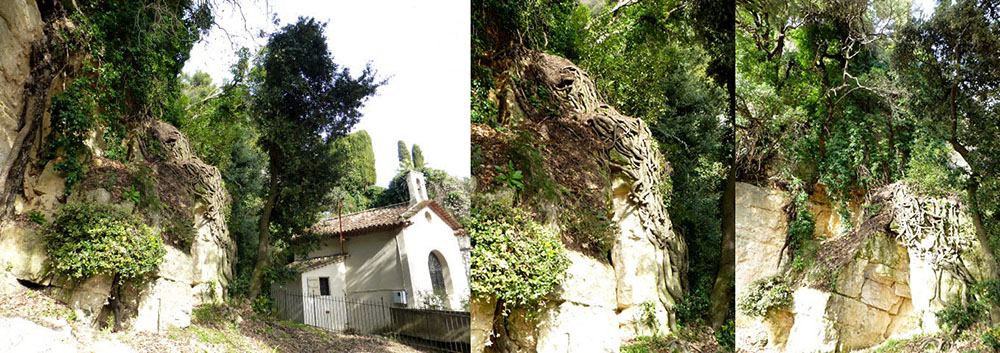

The approaches to the Chapel Garden are as important as the garden itself. It is seen from a long way off, and we felt it important to introduce the planting theme along these approaches by intermingling woodland plants with those on the terrace and steps leading to the garden.
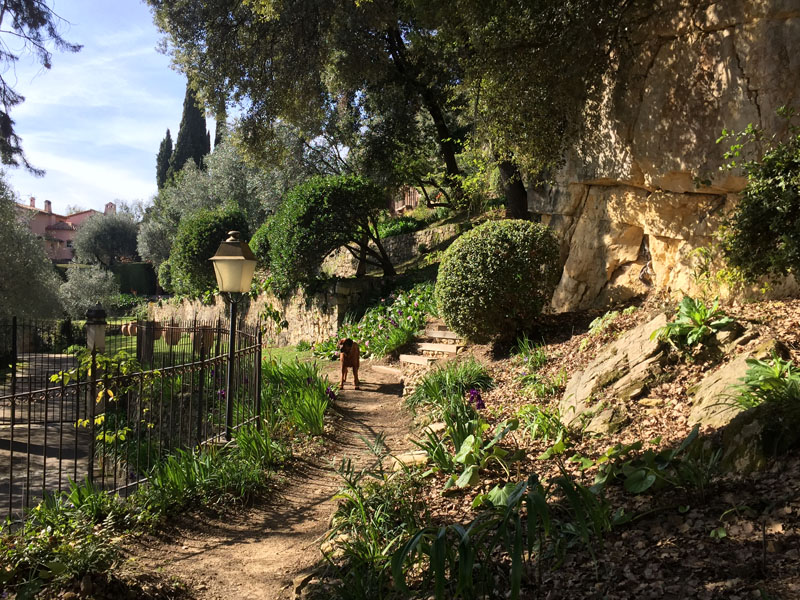
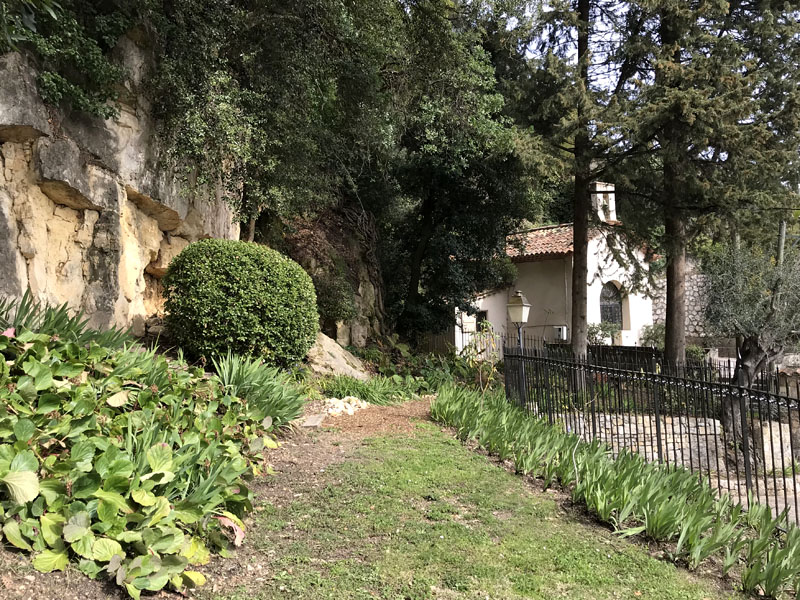
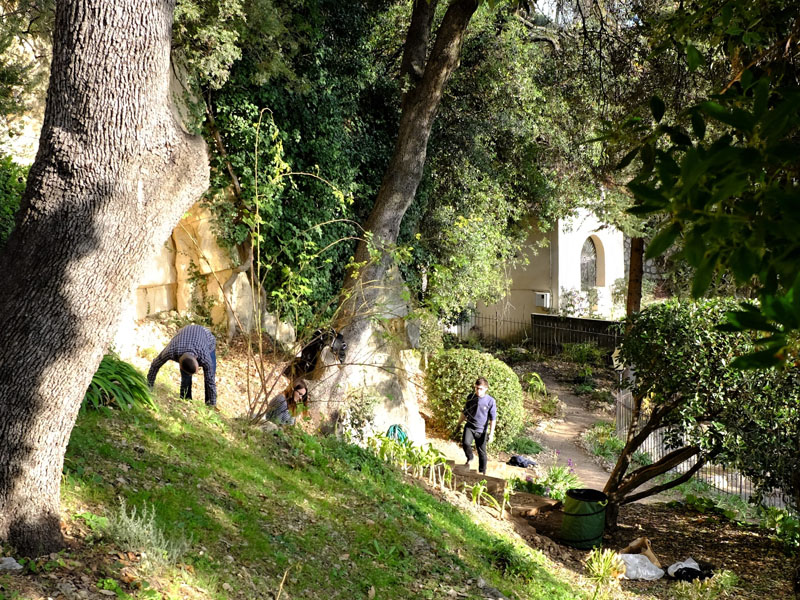
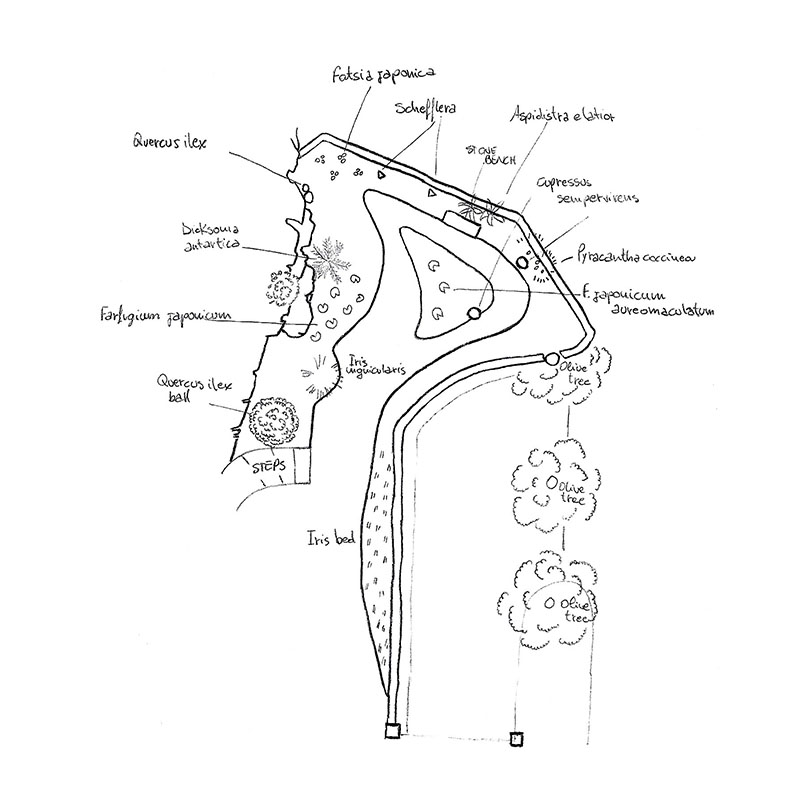
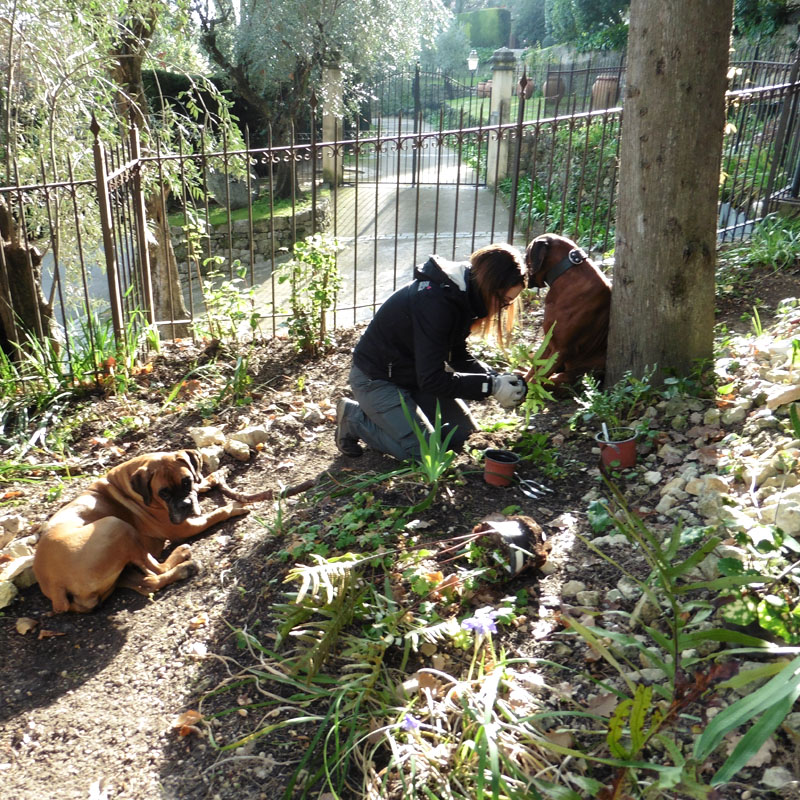
Here we are planting the second selection of ferns (see below), including: Iris formosana, Polypodium cambricum 'Hornet', Pteris nipponica, Dryopteris sieboldii, Farfugium japonicum forme frisée, Cyrtonium fortuneii cultivar, Polypodium cambricum 'Pulcherrimum'
The space behind the clipped shrub is filled with the bulbs of Lycoris radiata, which produce flambouyant lily-like flowers in autumn. Geranium maderense is also self-seeding amongst the Iris unguicularis in this area.
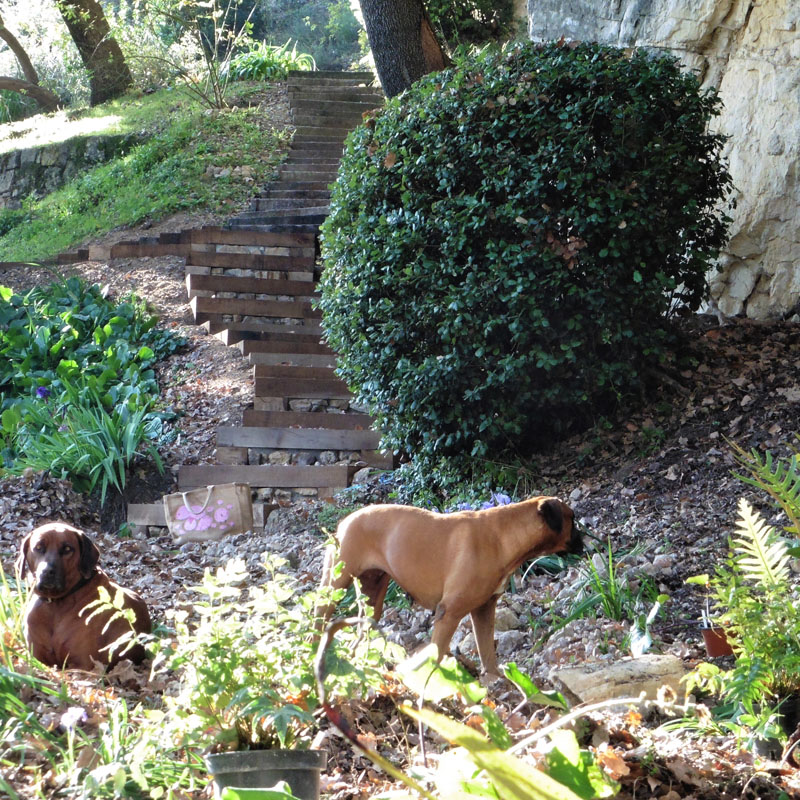
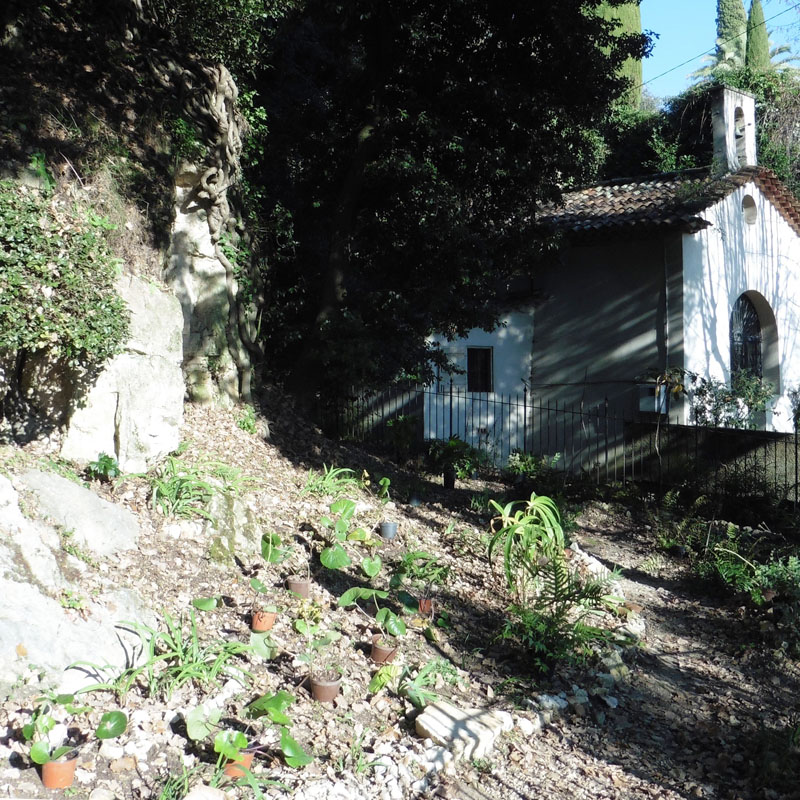
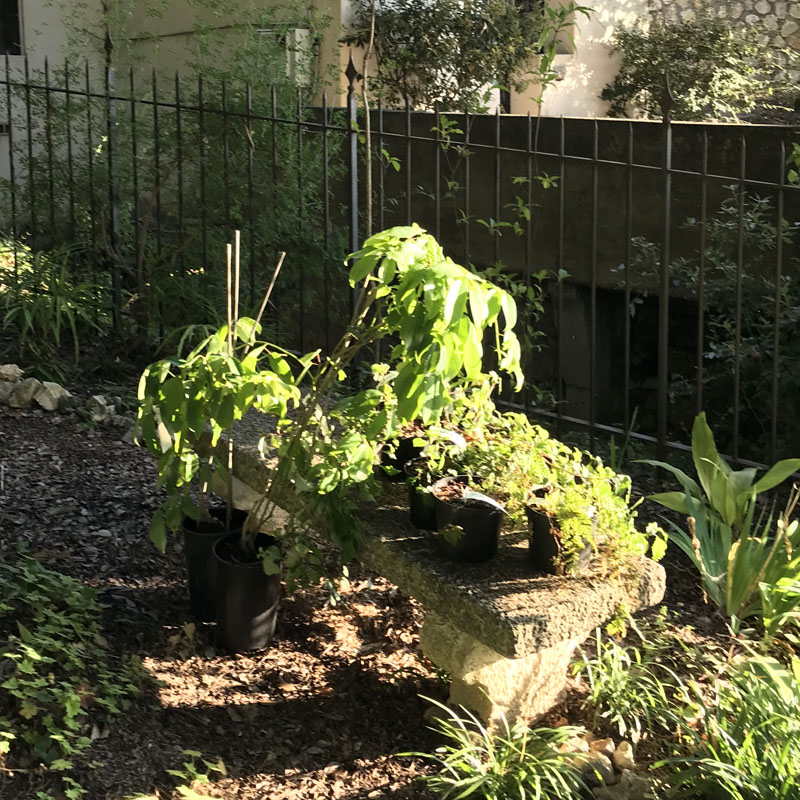
We continue our planting on a yearly basis – this latest selection includes some unusual varieties of Aspidistra which were found by our plant hunter friends, Sue and Bleddyn Wynn-Jones during their expeditions to Taiwan. Some of these grow in limestone cliffs in their natural habitat, which encouraged us to try this too.
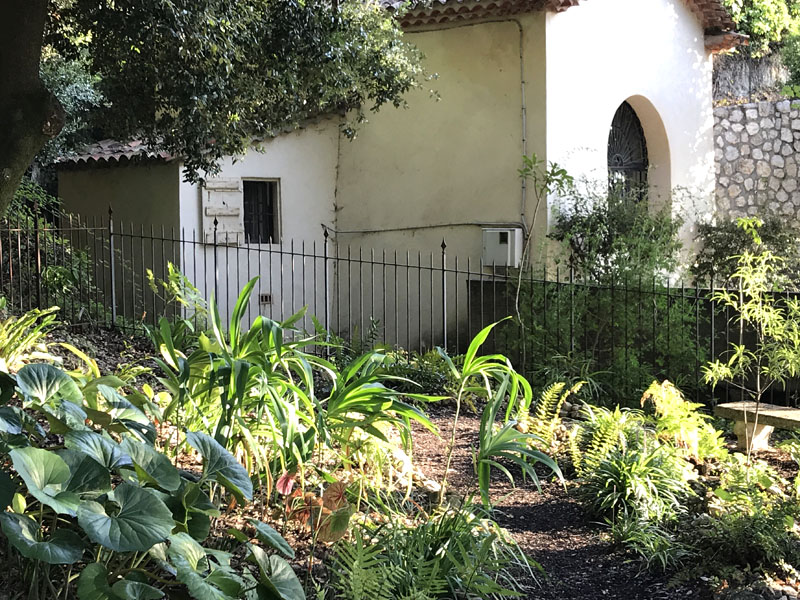
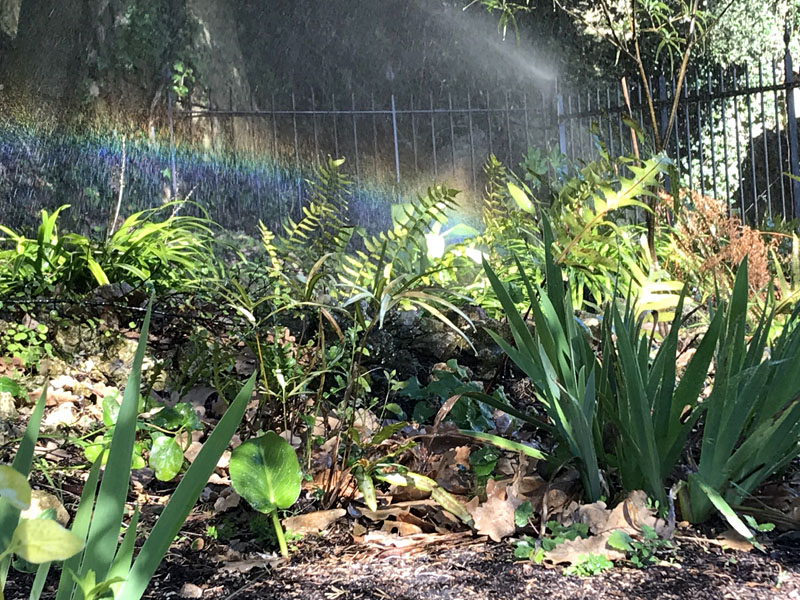
The regular attention to watering has enabled the plants to mature and we find the ferns building up to a decent size, so too for the Ligularias. Some of the more exotic plants are less ready to settle in securely. For example, we have planted at least six Scheffleras, but only a couple are properly settled. The most difficult area is near the trunk and main roots of the huge cypress. This is to be expected as it is well known- that many conifers inhibit the growth of other species near their roots.
The maintenance programe for the Chapel Garden is relatively simple – an occasional clean-up of dead and excessive foliage, path clearance, and monitoring the watering system. For several years we did this by handwatering the newly planted subjects, and ensuring the established plants are well mulched with fallen leaves (our leaf mould is excellent!). Recently we have installed an overhead misting system, which will be used only in the summer drought period, for a few minutes twice a day. This will use much less water over the period than the more difficult to regulate hand watering.
Plant List
Climbers
- Aristolochia baetica
- Stauntonia hexaphylla
- Schisandra rubiflora 'Bodnant Redberry'
Shrubs / small trees
- Fatsia japonica
- Fatsia polycarpa
- Oreopanax xalapensis
- Pyracantha sp.
- Schefflera fansipanensis (Vietnam)
- Schefflera pauciflora
- Schefflera taiwaniana x gracilis
- Viburnum fansipanense (Vietnam)
Ferns
- Cyrtomium falcatum
- Cyrtomium fortunei - Japanese Holly Fern
- Dryopteris sieboldii
- Nephrolepis flexuosa
- Niphidium crassifolium
- Phlebodium pseudoaureum
- Polypodium cambricum 'Hornet'
- Polypodium cambricum omnilacerum 'Oxford'
- Pteris nipponica
- Pteris umbrosa 'Major'
Perennials
- Anthropodium candidum purpureum
- Aristea ecklonii
- Asparagus aff. meioelados
- Aspidistra attenuata
- Aspidistra daibuensis (Cast-iron plant)
- Aspidistra eliator
- Aspidistra fasciaria
- Aspidistra mushaensis
- Aspidistra sichuanensis
- Aspidistra vietnamensis
- Aspidistra zongbayi 'Uan Fat Lady'
- Beesia calthifolia
- Begonia grandis alba
- Bergenia cilliata
- Bergenia 'Mrs Crawford'
- Bergenia sp.
- Curculigo crassifolia
- Dianella caerula
- Disporopsis arisanensis
- Disporum longistylum
- Farfugium japonicum
- Farfugium japonicum 'Forme Frisée'
- Geranium macrorrhizum (Cranesbill)
- Geranium maderense
- Geranium psilostemon
- Helleborus 'Pirouette'
- Helleborus x ericsmithii
- Leucosceptrum stellipilum v. formosanum
- Ligularia japonica
- Liriope 'Monroe White'
- Liriope muscari 'Silver Ribbon'
- Lirope muscari (Turf Lily, lilyturf)
- Maianthemum aff. salvinii
- Muehlenbeckia complexa
- Neomarica caerula gracilis
- Pachysandra axillaris 'Crug's Cover'
- Pittosporum illicioides v. angustifolium
- Reineckia yunnanense 'Crug’s Linear'
- Rhaphidophora decursiva.
- Rohdea tonkinensis
- Rohdea japonica
- Rhodoleia parvipetala
- Rubus lineatus (from Vietnam)
- Rubus pectinellus v. trilobus
- Rubus rolfei
- Ruscus heptophylla
- Speirantha convallarioides
- Strobilanthes flexicaulis
- Strobilanthes rankanensis
- Talbotia elegans
- Tupistra tonkinensis
- Tupistra aurantiaca
Bulbs
- Arisaema concinnum
- Arisarum proboscidium
- Arum italicum 'marmoratum' (Marbled large cuckoo pint, Arum d’Italie)
- Arum pictum (cuckoo pint, Lords and Ladies, Guet maculé)
- Crinum sp.
- Eranthis hymelis
- Iris formosana
- Iris germanica
- Iris japonica 'Confusa'
- Iris lazica
- Iris unguicularis (Algerian Iris)
- Lycoris aurea
- Lycoris radiata
- Lycoris squamagera
- Polygonatum verticilliatum
- Roscoea purpurea 'Vannin'
Supplier List
- Crûg Farm Plants: North Wales, UK
www.crug-farm.co.uk - Beth Chatto Gardens: Essex, UK
www.bethchatto.co.uk/ - Woottens of Wenhaston: Suffolk, UK
www.woottensplants.com - Le Monde des Fougères : Roquefort-les-pins, France
www.pepiniereezavin.com - Les Rosiers de Mougins: Mougins, France
www.lesrosiersdemougins.fr - Bulb’Argence: Fourques, France
www.bulbargence.com/fr - Pépinieres Pellizzarro: Vallauris, France